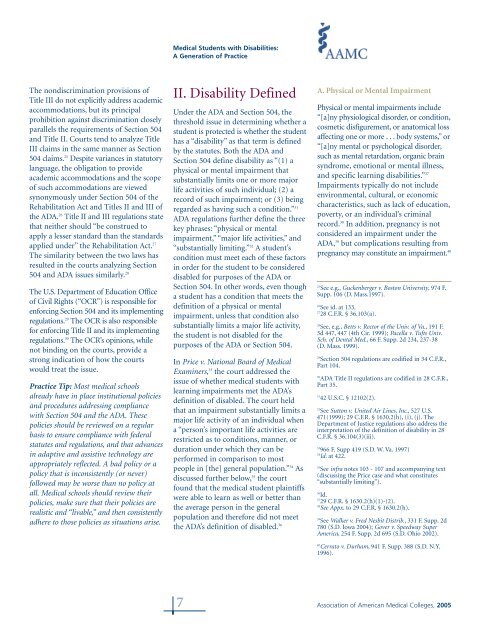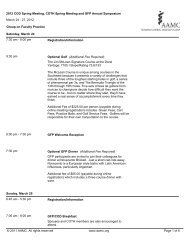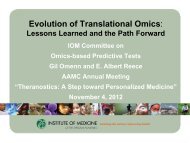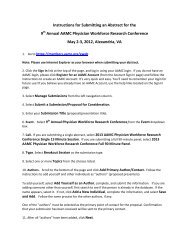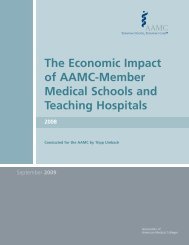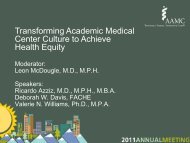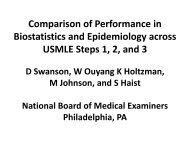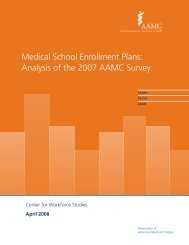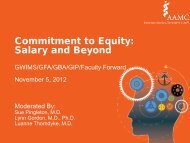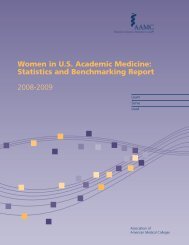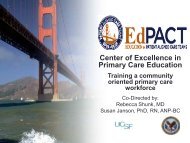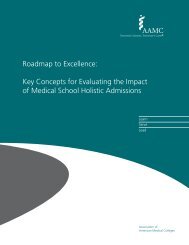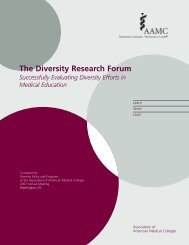Medical Students with Disabilities: A Generation of Practice
Medical Students with Disabilities: A Generation of Practice
Medical Students with Disabilities: A Generation of Practice
Create successful ePaper yourself
Turn your PDF publications into a flip-book with our unique Google optimized e-Paper software.
<strong>Medical</strong> <strong>Students</strong> <strong>with</strong> <strong>Disabilities</strong>:<br />
A <strong>Generation</strong> <strong>of</strong> <strong>Practice</strong><br />
The nondiscrimination provisions <strong>of</strong><br />
Title III do not explicitly address academic<br />
accommodations, but its principal<br />
prohibition against discrimination closely<br />
parallels the requirements <strong>of</strong> Section 504<br />
and Title II. Courts tend to analyze Title<br />
III claims in the same manner as Section<br />
504 claims. 25 Despite variances in statutory<br />
language, the obligation to provide<br />
academic accommodations and the scope<br />
<strong>of</strong> such accommodations are viewed<br />
synonymously under Section 504 <strong>of</strong> the<br />
Rehabilitation Act and Titles II and III <strong>of</strong><br />
the ADA. 26 Title II and III regulations state<br />
that neither should “be construed to<br />
apply a lesser standard than the standards<br />
applied under” the Rehabilitation Act. 27<br />
The similarity between the two laws has<br />
resulted in the courts analyzing Section<br />
504 and ADA issues similarly. 28<br />
The U.S. Department <strong>of</strong> Education Office<br />
<strong>of</strong> Civil Rights (“OCR”) is responsible for<br />
enforcing Section 504 and its implementing<br />
regulations. 29 The OCR is also responsible<br />
for enforcing Title II and its implementing<br />
regulations. 30 The OCR’s opinions, while<br />
not binding on the courts, provide a<br />
strong indication <strong>of</strong> how the courts<br />
would treat the issue.<br />
<strong>Practice</strong> Tip: Most medical schools<br />
already have in place institutional policies<br />
and procedures addressing compliance<br />
<strong>with</strong> Section 504 and the ADA. These<br />
policies should be reviewed on a regular<br />
basis to ensure compliance <strong>with</strong> federal<br />
statutes and regulations, and that advances<br />
in adaptive and assistive technology are<br />
appropriately reflected. A bad policy or a<br />
policy that is inconsistently (or never)<br />
followed may be worse than no policy at<br />
all. <strong>Medical</strong> schools should review their<br />
policies, make sure that their policies are<br />
realistic and “livable,” and then consistently<br />
adhere to those policies as situations arise.<br />
II. Disability Defined<br />
Under the ADA and Section 504, the<br />
threshold issue in determining whether a<br />
student is protected is whether the student<br />
has a “disability” as that term is defined<br />
by the statutes. Both the ADA and<br />
Section 504 define disability as “(1) a<br />
physical or mental impairment that<br />
substantially limits one or more major<br />
life activities <strong>of</strong> such individual; (2) a<br />
record <strong>of</strong> such impairment; or (3) being<br />
regarded as having such a condition.” 31<br />
ADA regulations further define the three<br />
key phrases: “physical or mental<br />
impairment,” “major life activities,” and<br />
“substantially limiting.” 32 A student’s<br />
condition must meet each <strong>of</strong> these factors<br />
in order for the student to be considered<br />
disabled for purposes <strong>of</strong> the ADA or<br />
Section 504. In other words, even though<br />
a student has a condition that meets the<br />
definition <strong>of</strong> a physical or mental<br />
impairment, unless that condition also<br />
substantially limits a major life activity,<br />
the student is not disabled for the<br />
purposes <strong>of</strong> the ADA or Section 504.<br />
In Price v. National Board <strong>of</strong> <strong>Medical</strong><br />
Examiners, 33 the court addressed the<br />
issue <strong>of</strong> whether medical students <strong>with</strong><br />
learning impairments met the ADA’s<br />
definition <strong>of</strong> disabled. The court held<br />
that an impairment substantially limits a<br />
major life activity <strong>of</strong> an individual when<br />
a “person’s important life activities are<br />
restricted as to conditions, manner, or<br />
duration under which they can be<br />
performed in comparison to most<br />
people in [the] general population.” 34 As<br />
discussed further below, 35 the court<br />
found that the medical student plaintiffs<br />
were able to learn as well or better than<br />
the average person in the general<br />
population and therefore did not meet<br />
the ADA’s definition <strong>of</strong> disabled. 36<br />
A. Physical or Mental Impairment<br />
Physical or mental impairments include<br />
“[a]ny physiological disorder, or condition,<br />
cosmetic disfigurement, or anatomical loss<br />
affecting one or more . . . body systems,” or<br />
“[a]ny mental or psychological disorder,<br />
such as mental retardation, organic brain<br />
syndrome, emotional or mental illness,<br />
and specific learning disabilities.” 37<br />
Impairments typically do not include<br />
environmental, cultural, or economic<br />
characteristics, such as lack <strong>of</strong> education,<br />
poverty, or an individual’s criminal<br />
record. 38 In addition, pregnancy is not<br />
considered an impairment under the<br />
ADA, 39 but complications resulting from<br />
pregnancy may constitute an impairment. 40<br />
25<br />
See e.g., Guckenberger v. Boston University, 974 F.<br />
Supp. 106 (D. Mass.1997).<br />
26<br />
See id. at 133.<br />
27<br />
28 C.F.R. § 36.103(a).<br />
28<br />
See, e.g., Betts v. Rector <strong>of</strong> the Univ. <strong>of</strong> Va., 191 F.<br />
3d 447, 447 (4th Cir. 1999); Pacella v. Tufts Univ.<br />
Sch. <strong>of</strong> Dental Med., 66 F. Supp. 2d 234, 237-38<br />
(D. Mass. 1999).<br />
29<br />
Section 504 regulations are codified in 34 C.F.R.,<br />
Part 104.<br />
30<br />
ADA Title II regulations are codified in 28 C.F.R.,<br />
Part 35.<br />
31<br />
42 U.S.C. § 12102(2).<br />
32<br />
See Sutton v. United Air Lines, Inc., 527 U.S.<br />
471(1999); 29 C.F.R. § 1630.2(h), (i), (j). The<br />
Department <strong>of</strong> Justice regulations also address the<br />
interpretation <strong>of</strong> the definition <strong>of</strong> disability in 28<br />
C.F.R. § 36.104(3)(iii).<br />
33<br />
966 F. Supp 419 (S.D. W. Va. 1997)<br />
34<br />
Id. at 422.<br />
35<br />
See infra notes 103 - 107 and accompanying text<br />
(discussing the Price case and what constitutes<br />
“substantially limiting”).<br />
36<br />
Id.<br />
37<br />
29 C.F.R. § 1630.2(h)(1)-(2).<br />
38<br />
See Appx. to 29 C.F.R. § 1630.2(h).<br />
39<br />
See Walker v. Fred Nesbit Distrib., 331 F. Supp. 2d<br />
780 (S.D. Iowa 2004); Gover v. Speedway Super<br />
America, 254 F. Supp. 2d 695 (S.D. Ohio 2002).<br />
40<br />
Cerrato v. Durham, 941 F. Supp. 388 (S.D. N.Y.<br />
1996).<br />
7 Association <strong>of</strong> American <strong>Medical</strong> Colleges, 2005


